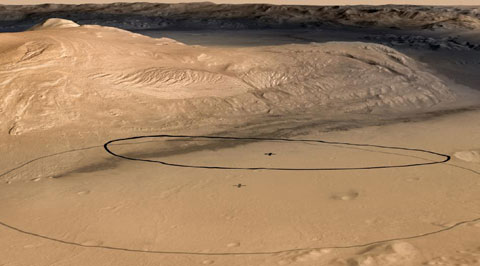
Diamonds may not lose their place in the hearts of those who love them, but for scientists at NASA’s Jet Propulsion Laboratory taking aim at Mars in the latest search for signs of life, there is a rival: “We have a rock unit that we’ve grown quite fond of,” said John Grotzinger of the California Institute of Technology and Mars Science Laboratory project scientist.
The rock formation in question, a “high thermal inertia unit,” is one of the strongest contenders on an itinerary for the Curiosity rover speeding toward an Aug. 5 landing. The formation, close to the hoped-for touchdown, is a possible location of evidence of water, if not water itself—one of the key ingredients for life.
“If water had been flowing into this area, it might have left a deposit,” said Grotzinger, adding the more precise landing plan announced June 11—with a smaller possible landing zone that puts the robotic rover closer to its final destination—is good news for science. “This is really an optimum outcome.”
NASA released a rendering of the Martian surface depicting Mount Sharp and the Gale Crater where Curiosity will land (if all goes well), with an ellipse measuring 12 miles by 16 miles superimposed to represent the original target landing area. A smaller ellipse—four miles by 12 miles, covers the area within which the car-sized rover is now expected to land and begin a two-year road trip.
Even the original target area—shrunk by improved simulations and in-flight calibration of instruments—was the smallest yet. There remain several hazards left to navigate, including atmospheric entry at 13,200 mph, a seven-minute descent and autonomous landing, and other pitfalls that explain why six in 10 previous missions to the Red Planet wound up as wreckage, or deep space junk.
“The reality is, this is a very risky business,” said Dave Lavery, NASA’s MSL program executive.
Even if all goes well, Curiosity is unlikely to settle the big question with definitive proof of life, past or present. The most likely candidates for Martian inhabitants are microscopic. Curiosity is not equipped to find or identify such tiny life, but could dig up clues tantalizing enough to support a return trip to collect samples for a closer look.
Scientists are meanwhile working to overcome technical obstacles to a successful search, even as the rover speeds through space. It was discovered not long before launch that contamination results from a manmade drill bit boring into Martian rock, an interaction that can produce Teflon, among other things. That discovery led to a roughly $2 million effort (funded by contingency dollars), with teams working hard toward a variety of possible solutions.
“We have been in the back room working away,” Grotzinger said. “We don’t have enough information yet to really know how serious the problem is.”
Curiosity will be the first earthly visitor to Mars equipped to drill into rocks, and is also rigged for the kind of long road trip that might inspire verses of “ninety nine thousand high thermal inertia units on the wall…”
MSL Project Manager Pete Theisinger said that so far, the spacecraft has been “extremely well-behaved.”
It could be hours or days after the fact before the team can collectively exhale and celebrate landing: On Aug. 5 (Aug. 6 in Eastern and Central time zones), no less than 14 minutes will pass before the Curiosity’s first messages from the surface arrive, thanks to the challenges of communicating over vast distance. A day or two could pass before the first message arrives if there are radio problems.
“You feel like a racehorse in the gate: You’re anxious but you’re also poised,” said Theisinger, of the Jet Propulsion Laboratory, in Pasadena, Calif., who has endured similar waits before. “You feel the best when you think you’ve done everything you can do.”
The target landing area was shifted as it shrunk, with the aim point moved to avoid hazards familiar to any pilot: bad terrain. Within the final target area, “there’s a place or two where we don’t want to land but they’re very, very small,” Theisinger said.
The final descent trajectory will be nudged one way or another by atmospheric conditions—Martian weather that is impossible to predict—accounting for some of the remaining uncertainty.
Theisinger sounded the most optimistic note of the day: “We’ll be fine.”



